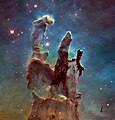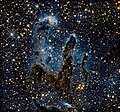Податотека:Eagle Nebula - GPN-2000-000987.jpg

Големина на овој преглед: 606 × 600 пиксели. Други разделности: 242 × 240 пиксели | 485 × 480 пиксели | 776 × 768 пиксели | 1.035 × 1.024 пиксели | 1.944 × 1.924 пиксели.
Изворна податотека (1.944 × 1.924 пиксели, големина: 1,18 МБ, MIME-тип: image/jpeg)
Историја на податотеката
Стиснете на датум/време за да ја видите податотеката како изгледала тогаш.
| Датум/време | Минијатура | Димензии | Корисник | Коментар | |
|---|---|---|---|---|---|
| тековна | 01:30, 3 октомври 2012 |  | 1.944 × 1.924 (1,18 МБ) | Ras67 | losslessly cropped with Jpegcrop |
| 02:17, 9 април 2009 |  | 1.993 × 1.973 (1,45 МБ) | BotMultichillT | {{Information |Description={{en|1=These eerie, dark pillar-like structures are columns of cool interstellar hydrogen gas and dust that are also incubators for new stars. The pillars protrude from the interior wall of a dark molecular cloud like stalagmite |
Употреба на податотеката
Податотекава се користи во следнава страница:
Глобална употреба на податотеката
Оваа податотека ја користат и следниве викија:
- Употреба на ar.wikipedia.org
- Употреба на arz.wikipedia.org
- Употреба на en.wikipedia.org
- Употреба на eu.wikipedia.org
- Употреба на fa.wikipedia.org
- Употреба на hu.wikipedia.org
- Употреба на ka.wikipedia.org
- Употреба на kw.wikipedia.org
- Употреба на uk.wikipedia.org
- Употреба на zh.wikipedia.org




